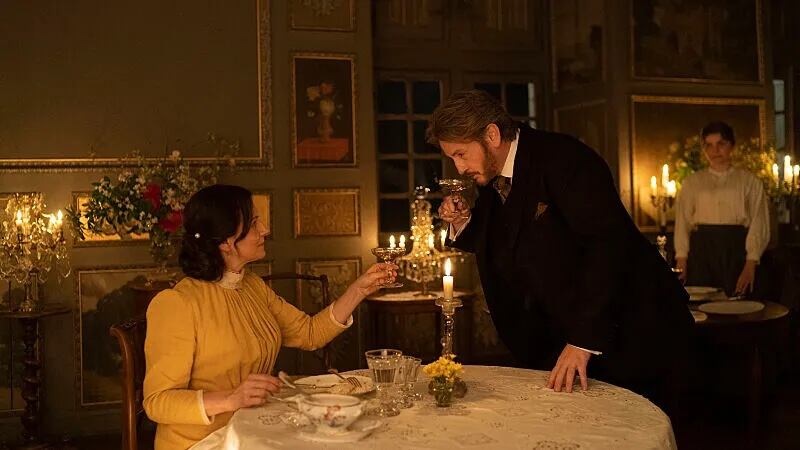“The Taste of Things” is easily one of the most exquisite visual feasts in cinema, exhibiting an unbelievable display of gourmet food, stunning landscapes and the always delightful Juliette Binoche. She stars alongside actor and her former husband, Benoît Magimel, in their first film together in over 20 years.
The two come together in a love story that is equally an ode to French cuisine. It is all about the senses and the way that they help us navigate the world around us; being conscious of all our sensations is being the most alive.
It is directed by acclaimed French-Vietnamese filmmaker, Trần Anh Hùng, who has made Japanese, English, Vietnamese and French films. Between both of his Academy Award-recognized titles, “The Taste of Things” and his 1994 film “The Scent of Green Papaya,” he communicates a vested interest in dwelling on the senses.
We find ourselves in the vast and flourishing countryside of Loire Valley in the Pays de la Loire region in late 1800s Western France. Eugenie and Dodin spend their days eating and cooking. Dodin is a gourmet and Eugenie is his chef; they work with two apprentices who help them to carry out meals. The young Bonnie Chagneau-Ravoire shines as Pauline, who shows exceptional promise as a young chef, displaying her ability to detect ingredients by taste early on.
Much of this movie is simply bearing witness to the heavenly display of garden-plucked vegetables, fresh fish, meats and desserts. Each more decadent than the one before, this film is responsible for the most audible gasps ever heard in a theater. A dollop of cream fresh from the stove was met with a frenzy of sounds typically associated with fornication. In other words, this film takes food porn and makes it art.
Hung takes great care to ensure that the audience is as invested in the process as the result. Each dish is prepared from scratch with the utmost precision and effort. We watch them delicately wash and chop, swirling oil over the large pans and placing bread into the wood-fired brick ovens. It is mesmerizing and sensual, helped by the arresting cinematography of Jonathan Ricquebourg, who captures the idyllic villa with elegant shots and rich lighting.
One of the film’s previous titles, “The Passion of Dodin Bouffant,” conveys the backbone of the story which is Dodin’s unwavering love for Eugenie and food. For both, he exhibits great patience and consideration. The two have an unconventional arrangement for the time: she works for him, yet holds the power. She refuses to get married to maintain her freedom, which he accepts gladly, though proposes to her earnestly and often just to be sure. Each night he slips down the hallway and checks to see if her door is open. If it is, he comes in and stays with her. If it is not, that is okay, too.
The way the two understand each other is evident in all parts of their lives, never needing to explain themselves or explicitly communicate. There is an obvious intimacy between them and so much is transferred with looks or touch. And, often, with food.
“The Taste of Things” is an ode to pleasure. Through the camera work, the lingering stares or joyful consumption of every bite, that pleasure is magnified. It feels as though Hung decided that people don’t relish enough. Modern society moves at an unromantic speed: fast food, the Internet, preservatives and microwaves. There isn’t time in the day between appointments and errands to savor.
As we move through the experience of watching the film, we settle into the indulgence of it. After first marveling at the sheer dedication these two put into making each meal, we start with impatience and eagerness, waiting for the final reveal and moving into a languid enjoyment of the expedition. From melting the butter to finding the perfect placement of the garnish on its way out the door, we learn to appreciate each moment.

It comes as no surprise that Binoche delivers a performance that is completely captivating from start to finish. She brings to Eugenie such a strong internal presence and sense of self-assurance. This was my first experience watching Benoît Magimel, but he holds his own. As Dodin, his harsher exterior, necessary for a purist and regimented cook of his caliber, is softened by the gentleness he brings to each movement. Both performers convey a breadth of emotion and narrative with just a look.
It is an astounding, beautiful film. It feels like the kind of comfort movie that can be returned to time and time again with the same effectiveness. It is a literal feast for the senses: unapologetic in its decadence but has the depth in its storytelling to back it up.
“The Taste of Things” reflects on how we prepare food and consume it, and what those things mean about us. It calls into question the way that we respond to seasons, friendships, nature, and romance, and will have us thinking about those things differently.
But most of all, it is a banquet meant to be enjoyed, one delicious bite at a time.
“The Taste of Things” was French’s official submission for the Academy Awards and had its theatrical release on Feb 9, 2024.
